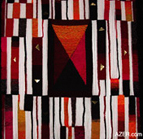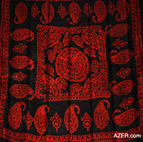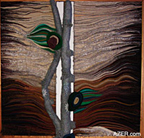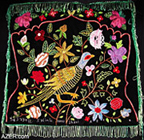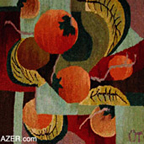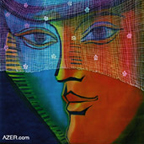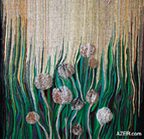|
Rafael went on to illustrate his point with music. "This synthesis," he said, "is evident in the work of Vagif Mustafazade and Jazz Mugham [see page 62]. If Vagif had not known and not based his jazz on the traditional modal scales of Azerbaijani mugham to go on to create mugham jazz, he would not be recognized today as a world-class jazzman. He would simply have been known as a great imitator of other great jazzmen." In relationship to the Textiles Competition, a trip was organized to the countryside to identify traditional textile artists. The following regions were visited by members of the organizing committee and the panel of jurors: (1) Qazakh, Agstafa and Ganja, (2) Aghsu, Shamakhi, and Maraza, (3) Ismayilli, Gabala and Shaki, (4) Guba and Gusar regions, as well as (5) settlements outside of Baku. The experts discovered that traditional textile art faces serious problems. Unfortunately, some of the traditional art forms are nearly extinct in Azerbaijan. Felt-making is one of them. Felt-making is characteristic of all Turkic nations and is one of the most ancient textile art forms. Many sheep breeders used to be involved in it. However, this art has almost died out. Only one artist could be found who does felt-Rauf Abdulhuseyn, who lives in Baku.
"Galamkar" is also on the wane. This art form resembles batik and involves drawing different ornamental symbols on cloth (batik is done on silk). Traditionally, galamkar was used for making tablecloths and scarfs. Kalaghayi is another similar art form like batik, but the ornaments are stamped on cloth, not drawn free hand. In many locations, carpet weaving was found to be diminishing. For example, in the Gazakh and Ganja region, non-piled carpets-palaz kilims-were no longer being woven. In fact, even the weaving of piled carpets was rare and in need of considerable support for revitalization. In Aghsu and Shamakhi, traditional colors are no longer being used. The traditional symbols are still being carried down from generation to generation, but the colors have changed because in remote locations it is so difficult to get wool that has been dyed with traditional natural colors. Consequently, bright, often gaudy-colored synthetics are being used. This, in turn, effects the harmony of colors. Carpets are no longer being woven there very much nor in the Gabala and Ismayilli regions in the north central areas of the country. Shaki, a charming, picturesque town, located in the foothills of the Caucasus, is traditionally known for its needlework. However, these days, neither the designs nor colors are traditional. Many types of piled carpet, such as chiyi, palaz, zili, sivama, and others have already died out.
According to Rafael, exhibitions such as this one serve to help preserve traditional values and customs in the art process. "Throughout history," he says, "nations have written their history on different materials including papyrus, stone, rice paper, wood or parchment. Azerbaijanis have written their ethnogeny and history on carpets and as such, they should not be allowed to disappear. The folk themselves have written their history in their carpets and passed them down from generation to generation. If traditional symbols are no longer incorporated into the design, it means that our history is being forgotten." Unocal Khazar
Ltd has been active in promoting the arts in Azerbaijan since
they were established in 1994. Mike Barnes as Unocal Khazar's
President was responsible for supporting this Textile and Needlework
Exhibition. |


